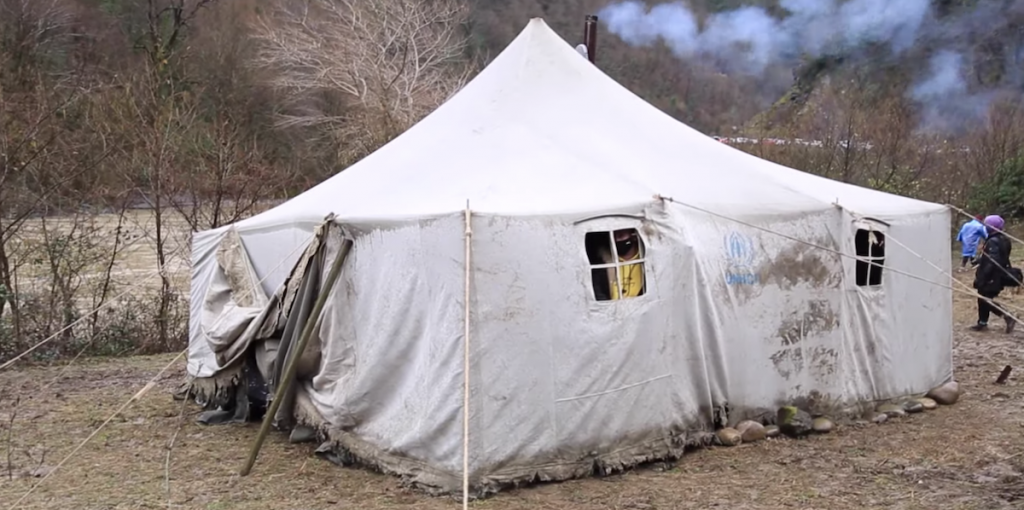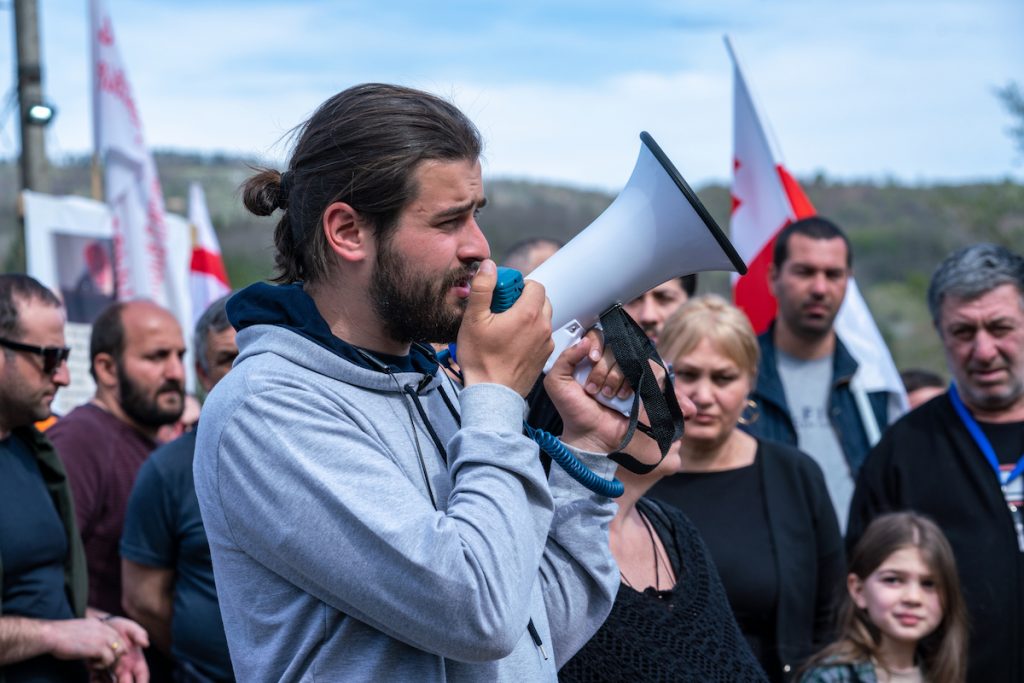'No to Namakhvani' - why the Rioni 'Guardians' don't want the hydropower plant
The Namakhvani HPP is the name of the largest energy project in the history of independent Georgia.
However, ecologists and local residents are strongly opposed to the construction of the power plant, fearing that a project of such a size will increase the seismic activity, change the local microclimate and damage unique grape varieties and the region’s wine production.
The project enjoys the full support of the Georgian government who claim that the risks are greatly exaggerated and that without the construction of new hydroelectric power plants, the energy security of Georgia will be undermined within the next few years.

“My village will no longer be here”
For over six months, local residents, environmentalists, and activists have been protesting in the Rion Gorge near the village of Namakhvani in Western Georgia, trying to prevent a Turkish company from beginning the construction of the hydroelectric power station.
The tents of the protesters are now located near the village of Namakhvani, and after the clashes with the police in April, the rally had to be moved several kilometers away, outside of the village of Gumati.

The activists call themselves the ‘protectors of the Rioni Gorge’ and, on May 23, they are planning to take their protest to the capital and promise not to disperse until the government suspends the Namakhvani HPP project.
“My village is located in the area that might be flooded if the project is implemented”, says one of the activists, 50-year-old Maka Suladze. Together with other protesters, Maka stayed for days in a tent in the village of Namakhvani.
The residents of the gorge have already lived under the fear of eviction once, back in the Soviet times, Maka recalls. However, back then, the discussion was still very hypothetical and concrete plans only began to be discussed since 2009:
“Since 2009, we have been living out of suitcases. We were born here, but we do not know where we will die”.
In 2012, when the now ruling Georgian Dream party was still a part of the country’s opposition bloc struggling to get into power, they promised local residents that they would not build the hydroelectric power station:
“We all trusted the Georgian Dream, they wrote right in their political program that they did not support the construction of large hydroelectric power plants”, Suladze says.
Today, the prospect of the complete disappearance of the village is more real than ever.
Approximately 300 families who are now living in the area of the construction of the hydroelectric power station – including the village of Maki – have already agreed to receive compensation and leave the valley.
However, other residents of the gorge refuse to leave their homes.
Project of historical significance – arguments in favor of the HPP
If the Namakhvan hydroelectric power plant is built, it will become the largest energy project in the history of independent Georgia.
Its investment value stands at $ 800 million and it will be constructed by the Turkish Enka Renewables Ltd company.
The hydroelectric power plant is planned to be constructed in the municipalities of Tskhaltubo and Tsageri, in the gorge of the Rioni River of Western Georgia.
The Namakhvani HPP project includes the construction of two plants – 60-meter-tall Tvishi with a capacity of 100 MW, and 111-meter-tall Namakhvani-Joneti with a capacity of 333 MW. The total capacity of the HPP is expected to reach 433 MW and the average annual generation is estimated at 1,500 GWh, which, as per the preliminary assessment of Enka, will amount to 12% of the country’s annual energy consumption.
The construction and management of the Namakhvan HPP will be carried out by Enka Renewables. 90% of the project is owned by the Turkish ENKA company, the general contractor, and the main investor of the project. The remaining 10% percent is owned by the Norwegian Clean Energy Group company.
The government claims that Namakhvani HPP is a “historic project” that will bring the country $ 800 million in direct foreign investment, make the country more energy-efficient and create up to 2,000 new jobs:
“The most important thing is the opportunity to employ up to 2,000 citizens of Georgia. These will mainly be local residents. We will definitely support this project”, said Minister of Economy Natia Turnava.
Turnava added that without the construction of new hydroelectric power plants in a few years, Georgia will be completely dependent on neighboring countries and will not be able to become energy independent.
She added that more than 35% of the energy consumed in Georgia is imported, and in the next ten years, when energy consumption in the country doubles (according to the current forecast, by 2030, energy consumption will double – from 13 billion kWh to 24 billion), Georgia will have to import half of what the country will consume.
Supporters of the plant also say that if the import of energy is exceeded, hundreds of millions of lari will be spent benefiting the economies of neighboring countries:
“During the 2020 pandemic alone, up to $ 200 million was withdrawn from the country for this purpose and spent on the economy, employment and budgets of our neighboring countries, and not ours”, Turnava said.
Giorgi Abramishvili, executive director of the Georgian Association for the Development of Renewable Energy Sources, says that the issue of building hydroelectric power plants in Georgia since the 1980s has traditionally been associated with “emotions and excitement” fueled by external forces:
“How long will we depend on the whims of neighboring countries, in which decisions are made only on the basis of political motives?! If we want real independence, we must start using the main natural resource of our country – water – efficiently and wisely”.
Giorgi Abramishvili says that the question is not about whether or not the power plants should be built, but rather about how to build them in a safer way.
“To speak about not building hydroelectric power plants is tantamount to betraying our country”, he said.
Hydroelectric plants in Georgia
Most of Georgia’s territory is covered with mountains, and, since Georgia is also rich in water resources, it is considered an ideal place for the construction of hydroelectric power plants.
In the history of independent Georgia, the construction of hydroelectric power plants became both an urgent and a problematic issue. Almost all projects for the construction of hydroelectric power plants are met with large-scale rallies, protests by local residents and environmentalists.
Any hydroelectric project – no matter how successful it is – has an impact on the environment and is often associated with human tragedies: large areas are flooded and people forced to leave their homes and ancestral graves.
On the other hand, HPPs provide energy security and independence for the country, therefore, a dispute between the supporters and opponents of the construction of hydroelectric power plants in Georgia has continued for many years.

◄ The first hydroelectric power station in Georgia was built in 1898, it was the Borjomi hydroelectric power station, which was supposed to solve the issue of power supply to the Likani Palace. Photo: Borjomi HPP ►
The boom in hydropower construction began during the communist era. In 1978, the Soviet government built a 251-meter-tall dam on the Inguri River, which, to this day, remains to be the largest hydroelectric power plant in Georgia and one of the country’s main sources of electricity.

◄Eduard Shevardnadze and other persons in charge of the Central Committee, the Council of Ministers, and the Presidium of the Supreme Council oversee the initial stage of construction of Khudoni. Photo: Tengiz Putkaradze, National Library Archives, 1985
Since 1985, the construction of the Khudoni hydroelectric power plant has been underway on the Inguri River, in the Khaishi community of Mestia municipality since 1985. The idea of building the Khudoni hydroelectric power station was first proposed in the 1970s. The construction work was launched, but the project was halted in the late 1980s due to the National Movement’s efforts, and the protests of student and local residents. The issue of building the Khudoni hydroelectric power station became relevant again in the 2000s. In June 2007, a memorandum was signed between the Georgian government and an Indian company, which has held the right to build a hydroelectric power station since 2011. However, construction has not yet begun due to protests of local residents and environmentalists. ►
Currently, 86 hydroelectric power plants, 5 thermal power plants, and 1 wind power plant generate electricity in Georgia.
At this stage, hydroelectric power plants cannot ensure the full energy independence of Georgia.
As per the official figures, Georgia consumed 12,157 million KWh last year. Of these, 11,159.8 million KWh of electricity was produced by the country itself (8248.2 million kWh was produced by hydroelectric power plants; 2820.8 million kWh was produced by thermal power plants), and 1,610.1 million KWh was imported.
The energy system of Georgia is characterized by the seasonality of energy consumption and generation – consumption in summer is relatively low, while generation, on the contrary, is high. Therefore, Georgia has the opportunity to export electricity in summer.
In winter, when the water level in the rivers decreases and consumption of energy increases, Georgia imports electricity, mainly from Russia and Azerbaijan.
In 2020, electricity imports from Russia reached a four-year high and accounted for almost half of total imports. Experts believe that given the fact that Russia is an unreliable partner and often uses energy resources for political purposes, the country’s growing dependence on Russian imports is dangerous.
The Georgian government is trying to fill the energy deficit with new projects.
Among them, is the Namakhvani hydroelectric power station, which, according to government officials and various experts, can make a significant contribution to the country’s energy security.
What are the opponents of Namakhvani HPP anxious about
The main threat that the opponents of the power plant often cite is security.
“This is the dam of death. It will be built on the top, most of the gorge will be flooded,”, said 28-year-old Varlam Goletani, leader of the Movement to Save the Rioni Gorge.
In addition, Varlam says that many villages in the region are in the landslide zone, and after the construction of the hydroelectric power station, the population of these villages will become eco-migrants.
These concerns are also shared by some environmentalists.
Environmental experts note that the possible impact of this large-scale project has not been adequately studied, and it could potentially be devastating.
“There are some studies on the Namakhvani HPP case that claim to be based on international best practices.
An environmental impact report prepared by Gamma Consulting states that the Kvemo Namakhvani project alone will sacrifice a large amount of arable land, flood five villages and relocate up to 300 families in total.
In addition, according to ecologists, the project is associated with serious seismic risks. Experts from the nongovernmental organization Green Alternative state that Namakhvani will not be able to withstand a magnitude 5 earthquake. Georgia is located in a seismically unstable region; in 1991, near the Rion Gorge, there was a devastating 7 magnitude earthquake.
The Institute of Geosciences of Ilia State University and the National Center for Seismic Monitoring also wrote a special letter to the government stating that the environmental impact assessment report prepared by the hydropower project “does not stand up to criticism in terms of geotechnical surveys”.
The institute staff even prepared a computer-simulated scenario that shows what will happen if the 105-meter dam of Nizhny Namakhvani is destroyed by an earthquake. The simulation shows that if the dam is damaged, a 34-meter wave will hit the second-largest city in Georgia, Kutaisi. However, the institute notes that the modeling was based on incomplete data and is not accurate.
Irakli Macharashvili, a representative of the Green Alternative organization, notes that the company, which received permission to build the Namakhvani HPP, in 2015 invested 400 million euros in the construction of another HPP in Georgia – the Shuakhevi HPP, but it collapsed within two months.
“The reconstruction of the Shuakhevo HPP cost an additional 200 million euros. Now it works, but no one has compensated the damage caused to nature and local residents”, Macharashvili said.
Another argument of the opponents revolves around the idea that hydroelectric power stations will completely change the environment in the region, as well as its cultural heritage and winemaking.
The Center for Social Justice (formerly EMC), which has studied the agreement between the Turkish company and the state of Georgia, says that Enka is actually using Georgia’s natural resources for free and is not obligated to sell energy on the domestic market:

“This negates arguments in favor of the country’s energy security or even economic benefits”, the organization said in a statement.
Local residents do not believe that the government will hire local residents to work for the hydropower plant:
“We are told that if a new hydroelectric plant is built, it will bring development and profit”, said Marita Museliani, one of the ‘Guardians of the Gorge’. A landslide came and blocked the road. Nobody helped the population. Where is the owner of the hydroelectric power station? In independent Georgia, the authorities behave like colonial administrations”..
The opinion of the local population is ignored in the negotiation process and this is a significant problem.
The state licenses the construction of hydroelectric power plants in Georgia, the land is mainly owned by the state, and therefore the investor negotiates directly with the state. In this way, local residents are excluded from the process.
In addition, the population does not trust the authorities and doubts that the expert opinions they provide are really qualified.
Enka calls these arguments myths and claims that the project is being carried out in accordance with the high safety standards and regulations of ICOLD (International Commission on Large Dams).
In particular, the project plans to build a concrete gravity dam, which is considered the most reliable, the company said.
The company also claims that the Namakhvani HPP is one of the most carefully planned projects.
Politics and HPPs
As the Movement to Save the Rion Gorge received wide public support, the government backed down and made a decision to suspend the construction of the main project facilities – the dam and reservoir. According to members of the government, work will resume after authoritative experts, including opponents of the project, re-examine the research and make sure that it is safe.
Observers identify several trends.

They note that this is a rare example of bottom-up protests: ‘Rioni’s Defenders’ managed to organize protests and gain support without the involvement of politicians.
Among the dangerous tendencies, experts note the anti-Turkish slogans, since a Turkish company will build the hydroelectric power station.
The Georgian director of Enka Renewables Merab Lominadze, as well as the Turkish manager of the company, note that the company’s employees have repeatedly opposed Turkey.
Turkish Ambassador to Georgia Fatma Jeren Yazgan considers anti-Turkish sentiments in the society a problem.
“The main investors in the project are from Turkey and Norway, but no one mentions Norway, and they only talk about the Turkish invasion and why the Georgian authorities are selling land to the Turks”, Fatma Jeren Yazgan said in an interview with the Georgian Public TV Company.
However, protest leaders, including Varlam Goletiani, have repeatedly called on their supporters to refrain from slogans that can be described as xenophobic.
Another problem is generalization: agitation is not only against this particular project, but also against the construction of hydroelectric power plants in general.

Giorgi Margebadze, executive director of the Association of Small and Medium Hydroelectric Power Plants, says many hydropower projects in Georgia have been suspended due to protests.
As he explains, small hydropower plants have exactly the same problems as large hydropower plants, and the population says that even if small hydropower plants are built, the dam will break and “divide the country”.
“Small and medium-sized hydroelectric power plants are fundamentally different from large hydroelectric power plants. No dams are being built here, but the problems are the same, people keep talking about cutting down trees and flooded villages. When we try to explain to the population that all this is not true, they do not pay attention, because the topic of a hydroelectric power station is demonized”, Margebadze said.
Environmentalists note that the mistrust in Georgia’s hydroelectric power plants will be fueled by inconsistent and opaque government policies.


















